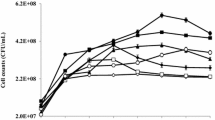Abstract
Three different green manures were added to the tea garden soils separately and incubated for 40 days. After, incubation, acetanilide herbicides alachlor and metolachlor were spiked into the soils, separately, followed by the isolation of bacteria in each soil at designed intervals. Several bacterial strains were isolated from the soils and identified as Bacillus silvestris, B. niacini, B. pseudomycoides, B. cereus, B. thuringiensis, B. simplex, B. megaterium, and two other Bacillus sp. (Met1 and Met2). Three unique strains with different morphologies were chosen for further investigation. They were B. megaterium, B. niacini, and B. silvestris. The isolated herbicide-degrading bacteria showed optimal performance among three incubation temperatures of 30°C and the best activity in the 10 to 50 μg/ml concentration of the herbicide. Each bacterial strain was able to degrade more than one kind of test herbicides. After incubation for 119 days, B. cereus showed the highest activity to degrade alachlor and propachlor, and B. thuringiensis to degrade metolachlor.






Similar content being viewed by others
References
Baiely AM, Coffey MD (1986) Characterization of microorganisms involved in accelerated biodegradation of metalaxyl and metolachlor in soils. Can J Microbiol 32:562–569
Chakraborty U, Chakraborty B, Basnet M (2006) Plant growth promotion and induction of resistance in Camellia sinensis by Bacillus megaterium. J Basic Microbiol 46:186–195
Chesters G, Simsiman GV, Levy J, Alhajjar BJ, Fathulla RN, Harkin JM (1989) Environmental fate of alachlor and metolachlor. Rev Environ Contam Toxicol 110:1–74
Dierickx PJ (1999) Glutathione-dependent cytotoxicity of the chloroacetanilide herbicides alachlor, metolachlor, and propachlor in rat and human hepatoma-derived cultured cells. Cell Biol Toxicol 15:325–332
El-Fantroussi S (2000) Enrichment and molecular characterization of a bacterial culture that degrades methoxy-methyl urea herbicides and their aniline derivatives. Appl Environ Microbiol 66:5110–5115
Ellgehausen H (1976) Project report 4/76: degradation of CGA-24705 in aerobic, anaerobic, and autoclaved soil, p. 41. Metolachlor Pesticide Registration Standard, Office of Pesticides and Toxic Substances, US Environmental Protection Agency, Washington, DC
FDA (1983) Use of the FDA surveillance index in planning pesticide residue monitoring programs, US Food and Drug Administration, Rockville, MD
Hayes TB, Case P, Chui S, Chung D, Haeffele C, Haston K, Lee M, Mai VP, Marjuoa Y, Parker J, Tsui M (2006) Pesticide mixtures, endocrine disruption and amphibian declines: are we underestimating the impact? Environ Health Prospect 114:40–50
Khoury R, Coste CM, Kawar NS (2006) Degradation of metribuzin in two soil types of Lebanon. J Environ Sci Health B 41:795–806
Krause A, Hancock WG, Minard RD, Freyer AJ, Honeycutt RC, MLeBaron H, Paulson DL, Liu SY, Bollag JM (1985) Microbial transformation of the herbicide metolachlor by a soil actinomycete. J Agric Food Chem 33:584–589
Liu Z, Yang H, Huang Z, Zhou P, Liu SJ (2002) Degradation of aniline by newly isolated extremely aniline-tolerant Delftia sp. AN3. Appl Microbiol Biotechnol 58:679–682
Novick NJ, Alexander M (1985) Cometabolism of low concentrations of propachlor, alachlor, and cycolate in sewage and lake water. Appl Environ Microbiol 49:737–743
Novic NJ, Mukherjee R, Alexander M (1986) Metabolism of alachlor and proparchlor in suspensions from pretreated soils and in samples from ground water aquifers. J Agric Food Chem 34:721–725
Rice PJ, Anderson TA, Coats JR (2002) Degradation and persistence of metolachlor in soil: effects of concentration, soil moisture, soil depth, and sterilization. Environ Toxicol Chem 21:2640–2648
Roslev P, Madsen PL, Thyme JB, Henriksen K (1998) Degradation of phthalate and di-(2-ethylhexyl)phthalate by indigenous and inoculated microorganisms in sludge-amended soil. Appl Environ Microbiol 64:4711–4719
Saxena A, Zhang R, Bollag JM (1987) Microorganisms capable of metabolizing the herbicide metolachlor. Appl Environ Microbiol 53:390–396
Sørensen SR, Ronen Z, Aamand J (2002) Growth in coculture stimulates metabolism of the phenylurea herbicide isoproturon by Sphingomonas sp. Strain SRS2. Appl Environ Microbiol 68:3478–3485
Topp E, Zhu H, Nour SM, MLewis SH, Cuppels D (2000a) Characterization of an atrazine-degrading Pseudaminobacter sp. Isolated from Canadian and fresh agricultural soils. Appl Environ Microbiol 66:2773–2782
Topp E, Mulbry WM, Zhu H, Nour SM, Cuppels D (2000b) Characterization of S-triazine herbicide metabolism by a Nocardiodies sp. Isolated from agricultural Soil. Appl Environ Microbiol 66:3134–3141
USEPA (1993) Drinking water regulations and health advisories. Office of Water, USEPA, Washington, DC
Villarreal DT, Turco RF, Konopka A (1991) Propachlor degradation by a soil bacterial community. Appl Environ Microbiol 57:2135–2140
Walker A, Welch SJ (1991) Enhanced degradation of some soil-applied herbicides. Weed Res 31:49–57
Walker A, Moon YH, Welch SJ (1992) Influence of temperature, soil moisture and soil characteristics on the persistence of alachlor. Pestic Sci 35:109–116
Wang YS, Subba-Rao RV, Alexander M (1984) Effect of substrate concentration and organic and inorganic compounds on the occurrence and rate of mineralization and cometabolism. Appl Environ Microbiol 47:1195–1200
Wang YS, Madsen EL, Alexander M (1985) Microbial degradation by mineralization or cometabolism determined by chemical concentration and environment. J Agric Food Chem 33:495–499
Weed Science Society of America. (1983) Herbicide handbook. 5th edn. Weed Science Society of America, Champaign, III
Yen JH, Hsiao FL, Wang YS (1997) Assessment of insecticide carbofuran to contaminate groundwater through soil in subtropics. Ecotoxicol Environ Safe 38:260–265
Yen JH, Lin KH, Wang YS (2000) Potential of the insecticides acephate and methamidophos to contaminate groundwater. Ecotoxicol Environ Safe 45:79–86
Yen JH, Chang SL, Wu CC, Wang YS (2005) Behavior of acetanilide herbicides in soils and the possibility of groundwater contamination. Bull Environ Contam Toxicol 75:1086–1093
Zimdahl RL, Clark SK (1982) Degradation of three acetanilide herbicide in soil. Weed Sci 30:545–548
Acknowledgments
This investigation was supported by funds provided by the National Science Council and Council of Agriculture, Administration Yuan, Taiwan, under Agreement NSC91-2313- B-002-350 and 92-AS-1.2.1-FD-Z1.
Author information
Authors and Affiliations
Corresponding author
Rights and permissions
About this article
Cite this article
Wang, YS., Liu, JC., Chen, WC. et al. Characterization of Acetanilide Herbicides Degrading Bacteria Isolated from Tea Garden Soil. Microb Ecol 55, 435–443 (2008). https://doi.org/10.1007/s00248-007-9289-z
Received:
Revised:
Accepted:
Published:
Issue Date:
DOI: https://doi.org/10.1007/s00248-007-9289-z




